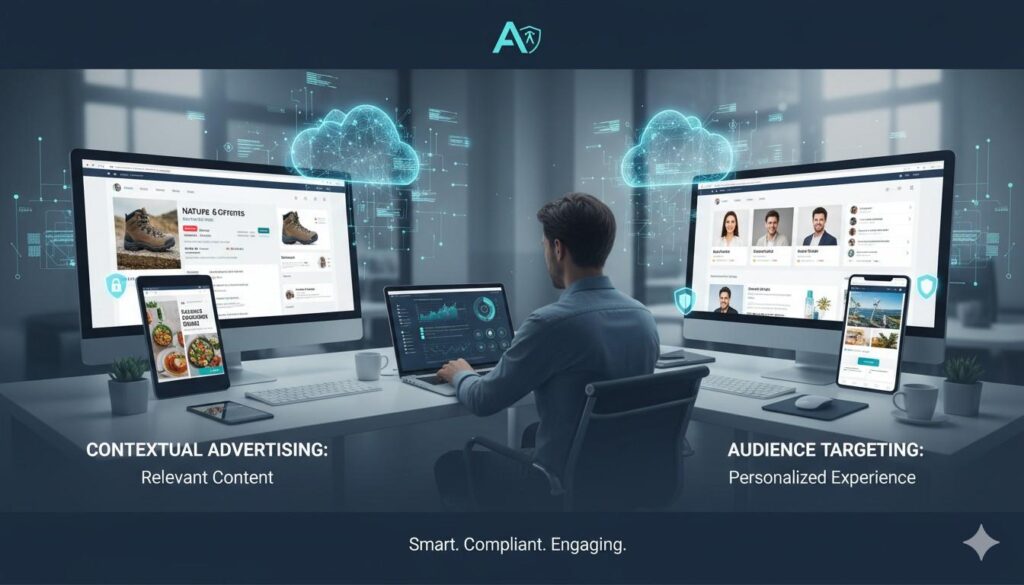Not long ago, audience segmentation was simple. You chose a demographic, maybe 25–34-year-old males, and hoped your campaign resonated. That approach worked when media consumption was predictable.
Today, YouTube has shattered that simplicity. A single user might start their day with a meditation video, take a break with a horror trailer, and end the evening on a productivity vlog. Viewing patterns are scattered. Communities have formed around niche creators. Attention spans are shorter. This means relevance has become the single most important factor in ad performance. Age and gender are no longer enough. To reach the right person at the right moment, you need to understand what they are watching, why they are watching it, and how they react to it. This is where Filament’s approach stands out. It blends audience targeting, contextual understanding, and brand safety to deliver campaigns that connect in the moments that matter.
Why Traditional Audience Segmentation No Longer Works
1. Demographic Targeting
Relying on age, gender, or income assumes that identity equals interest. On YouTube, two people in the same demographic may have completely different mindsets and habits.
The problems:
- Identity doesn’t equal intent: Two viewers in the same demographic can have vastly different interests and content habits. For example, a 35-year-old man watching a horror movie breakdown isn’t in the same mindset as one watching B2B SaaS explainer content.
- Context gets ignored: Demographic targeting doesn’t account for what someone is watching or why. You may be showing the right message to the wrong mindset.
- Wasted impressions add up: Ads get served based on age or income, not actual interest or readiness to engage, leading to high spending and low performance.
- Content behavior is more dynamic: Viewers don’t stick to one category on YouTube. Someone might watch fitness content in the morning and economic policy recaps at night.
Segmentation needs to go deeper than demographics to reach the right audience at the right moment. That’s where context, content alignment, and real viewing behavior start to matter.
2. Affinity and In-Market Audiences
Google’s built-in segments refine targeting slightly.
- Affinity audiences capture long-term passions like tech or fitness.
- In-market audiences track short-term buying intent, like people shopping for laptops or insurance.
They work for broad awareness but are often too vague for niche precision. If you want to reach “female SaaS founders watching growth marketing videos,” these tools alone will not get you there.
3. Keyword and Topic Targeting
On paper, this makes sense. Match ads to keywords or topics. In reality, YouTube metadata is messy. Creators often skip tagging, or tags are too broad to be useful. You might target “finance” and end up on risky crypto channels. Without proper content vetting, this is like walking into a conversation without knowing who is speaking or what they are really saying.
Modern Audience Segmentation Framework for YouTube Advertising
So, what works in 2025? A smarter model built around intent, context, behavior, and creative fit. These four pillars don’t just describe the audience. They describe how they’re thinking, what they’re watching, and how likely they are to respond.
1. Intent-Based Segmentation
A. In-Market & Purchase Intent
Yes, people still search for things like “best mortgage lenders” or “top-rated laptops.” And yes, targeting based on these behaviors works for bottom-of-funnel campaigns. But it’s competitive. Everyone’s chasing the same clicks. The creative bar is high, and audiences are flooded with similar messages. Filament sharpens intent by layering contextual filters. Instead of just targeting “laptop shoppers,” you can reach channels that blend buying intent with trusted, safe, high-performing content. It’s the difference between shouting into a crowd and having a 1:1 conversation with someone already engaged.
B. Custom Intent Audiences
If you know what your audience is Googling, you can build Custom Intent audiences around those searches. It’s a powerful, precise tool. But the real magic happens when you align that search intent with the kind of content they watch on YouTube. Filament allows you to sync search behavior with contextual targeting, finding the right creators, topics, and communities where that intent lives. If someone’s searching for “how to negotiate salary,” why not reach them inside a trusted career advice series instead of a random video with a similar tag?
2. Contextual Targeting: Precision Without Personal Data
A. Why Context Is Winning
With cookies fading and privacy tightening up, contextual targeting has made a major comeback, not just on YouTube but also in connected TV. If you’re expanding your reach, you can also implement contextual targeting in CTV campaigns to maintain precision without relying on personal data. And for good reason: context respects privacy, doesn’t rely on third-party tracking, and often produces more relevant, emotional engagements. Someone watching a “recession-proof budgeting” video is already thinking about money. You don’t need to guess if they’re interested in finance, you already know.
B. The Problem with Built-In Context Tools
Google gives you some basic tools: topic targeting, placement targeting, and keywords. But these are either too broad (topics like “lifestyle”), too manual (individual placements), or too surface-level (keywords in metadata). They don’t verify tone, flag unsafe creators, and analyze audience overlap or community dynamics.
C. How Filament Fixes It
Filament takes a hybrid approach: machine learning plus human oversight to map YouTube’s ecosystem and validate it for brand safety and performance. The result is a living index of pre-vetted, topic-rich, brand-safe content communities, powered by Filament’s proprietary tech stack that continuously analyzes, scores, and updates channel data to ensure precision targeting. Want to reach “digital detox” enthusiasts? Filament has that mapped. With Filament, you don’t have to play guessing games. You can build around a mindset, not just metadata.
3. Behavior-Based Segmentation
A. Segmenting by Attention
Not all views are created equal. Some people skip ads immediately, others linger, some binge content in the background, and others are fully engaged.
B. Smarter Retargeting
Classic remarketing still works, retarget people who visited your site, watched your videos, or engaged with your brand. But behavior-based signals make those audiences stronger. Example: Instead of retargeting all past viewers, focus on those who watched 75% of your video and spent more than 30 seconds on your site. Filament enables this kind of precision layering by combining watch behavior, site data, and content context.
4. Creative-Led Segmentation
A. Story Fit by Segment
Different segments require different narratives. It’s not just about targeting, it’s about speaking the right language. Some respond to humor, while others prefer concise, straight-to-the-point delivery. Knowing this means you can shape content that feels native to the content they’re watching. It’s not just an ad, it’s part of the conversation.
B. Creative Variants for Each Segment
Once you know what works, you can tailor your edits. Filament supports creative testing, which allows you to tweak hooks, pacing, and visuals per segment. Got a productivity segment? Run a 15-second fast-paced version. Talking to skeptical finance viewers? Test a casual explainer with a dry wit. Segmented creativity means more relevance, better results, and less wasted spend.
Measurement and Optimization by Segment
Segmentation only works if you measure it with the right KPIs, not just views or clicks. In fact, measuring YouTube ad success beyond surface metrics is key to understanding true impact. With Filament, you can analyze performance by segment, then double down on high-performers and suppress low-fit segments. Tie segment data to tools like Google Brand Lift, Search Lift, or Filament’s channel-level reporting for deeper insight. You’ll know who engaged, why, where, and what to do next.
Ready to Transform Your YouTube Strategy?
Get expert insights and proven strategies delivered to your inbox weekly
The Future: Relevance Over Reach
YouTube is not like TV, and it is not traditional digital media either, especially with its rise in connected TV viewership. Media buyers can adapt by exploring strategies from our YouTube CTV growth guide.
It is a fast, fragmented ecosystem full of opportunity if you know how to navigate it. The winning advertisers will:
- Target contextual communities instead of just demographics.
- Build segments around intent, behavior, and creative fit.
- Deliver the right message at the right moment in a safe environment.
Filament acts as the strategy layer connecting audience insight, contextual placement, and creative adaptation, turning YouTube advertising into a precision-driven performance channel.
FAQs
Why isn’t demographic targeting enough for YouTube advertising today?
Because demographics don’t tell you what someone is watching or why. Two people in the same age or income bracket can have different content habits and mindsets. On YouTube, relevance comes from context, not just identity.
How does Filament help with contextual audience segmentation on YouTube?
Filament maps YouTube’s content ecosystem into pre-vetted, brand-safe communities. It blends machine learning with human review to help advertisers target audiences based on mindset, topic, and content, not just broad categories.
What’s the difference between in-market targeting and contextual targeting?
In-market targeting focuses on purchase intent: people actively researching products. Conversely, contextual targeting places your ad within content that aligns with your message, even before someone starts searching. It’s intent + timing + environment.
Can I retarget YouTube viewers effectively using behavioral data?
Yes. You can go beyond basic retargeting by using engagement signals, like watch time and site activity. Filament helps refine these audiences by combining behavioral data with contextual channel insights for better precision.
How should creativity be adapted across different audience segments?
Different audiences respond to different tones, formats, and stories. Filament identifies what kind of creative resonates with each segment, whether that’s fast-paced explainers, narrative-led ads, or humor-driven content, so you can tailor for performance, not guesswork.

I’m a results-driven marketing leader with 10+ years of experience building integrated media strategies that drive measurable ROI. As COO and co-founder of Filament, I shape the product roadmap, sales, and campaign performance. My background spans brand and performance media for top brands like Slack, Bumble, and Jenny Craig. A frequent speaker on measurement, I bring deep expertise in ad tech, data strategy, and media buying—always with a sharp focus on business impact. Previously I founded an attribution company, where I led campaign planning, attribution modeling, and executive-level reporting across TV, digital, and CRM channels.



